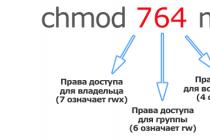Three ASUS power supplies were tested in our laboratory - A-30F, A-30G and A-30H.
Power supplies
In this article, I will allow myself not to adhere to the standard scheme for considering each power supply separately - the fact is that, as shown by a visual inspection, all three units have absolutely identical electronics, but differ only in cooling systems.As you know, the classic and most commonly used power supply cooling scheme is active cooling using an 80mm fan located on the back of the unit and pulling hot air out of it. This scheme is simple, cheap, but, unfortunately, on high-power units, it is relatively ineffective either in terms of cooling or in terms of noise generated during operation.
The fact is that in any ATX power supply there are four elements that need forced cooling - a group stabilization choke (in the photo below it is marked with the number "1"), a radiator with output diode assemblies (2), a power transformer (3) and a heatsink with key transistors (4), on which a standby stabilizer transistor is also often located (the photo shows the power supply not from ASUS, but from Codegen, model 250X1 - due to the lower mounting density, individual components are better visible in its example).
The hottest elements are the group stabilization choke and output rectifiers, however, they are located in the classic design just away from the main air flow created by the fan (generally speaking, I have come across power supplies in which these elements were located on the same side, as the fan, but these were single copies). Thus, in a powerful power supply unit, in which, accordingly, a greater amount of heat is generated, for acceptable cooling of the entire volume of the unit, it is necessary to increase the air flow, that is, the fan power. However, along with the power of the fan, the noise it produces also grows, which does not suit many buyers ...
The junior model - ASUS A-30F is made according to this scheme.

Pay attention to how the vents are made in the inner walls of the power supply - they are not located on one wall (usually the back or top), as in most units, but are distributed along different walls so that the resulting airflows cool the entire power supply. Separately made small holes for cooling the passive PFC choke.

The simplest and cheapest way out of this situation - installing a second fan on the back of the power supply - is not very effective and is usually used in inexpensive power supplies. The second fan is placed coaxially with the first one (or, in the best case, with a slight shift towards the center) and somewhat improves the airflow. power transformer and both radiators, since the air flow from it blows directly on them. The photo below shows the implementation of such a cooling scheme using the example of the Codegen 350X power supply:

In more expensive units - both newer models from Codegen and those discussed by ASUS - different cooling improvement schemes are used. Firstly, these are blocks with two 80-mm fans, which have gained considerable popularity, one of which is located in the usual place, and the other on the top wall of the power supply, and usually it is displaced to the center of the lid so that the air flow from it blows not only radiators, but also a group stabilization throttle located on the side of them. This, as well as the fact that the flow of cold (relatively, of course, because it is taken not from the outside, but from the computer case) air is directed directly to the radiators, can significantly improve the cooling efficiency and, accordingly, use less efficient and quieter fans.

A more expensive model from ASUS - A-30H is made according to this scheme. Instead of stamped grilles, the fans are now equipped with wire grilles, which also has a positive effect on the noise level.

Although, of course, the vents from the top cover have disappeared - now they are replaced by a fan - by back cover they have been preserved in the same place. There is also a row of holes left next to the passive PFC choke.
And, finally, the fourth power supply cooling scheme, which has also gained noticeable popularity recently, although inferior in prevalence to the scheme with two fans. In this scheme, a large 120 mm fan is installed on the top cover, which, firstly, occupies most of the cover, and therefore evenly blows all the components of the power supply that need it, and secondly, at relatively low speeds, it gives a fairly powerful air flow ... Therefore, there is no need for a fan on the back wall - in such a block, just perforation is made in its place. V lineup ASUS made the A-30G unit according to the scheme with one 120 mm fan.

Of course, the rear wall of the power supply is now deaf - it does not need additional air intake, on the contrary, with ventilation holes it would turn out that hot air from the power supply is blown back into the computer, which is clearly superfluous.

Testing
As I already noted, inside all three blocks are almost identical, so I will describe the contents of one of them (using the A-30H as an example), after which I will point out the differences between A-30F and A-30G.
A-30H
The block is made very neatly, which immediately makes a good impression. The inscription on the PCB says that the unit is actually manufactured by Enhance Electronics, and as a study of the site of this company shows, the ASUS A-30F corresponds to the Enhance ATX-1130F model, the A-30G unit corresponds to the Enhance ATX-1130G model, and the A-30H unit , respectively, is completely similar to the Enhance ATX-1130H. The PWM controller microcircuit - "Enhance 16880A" is also marked.
At the input of the unit, a set LC filter is installed on two chokes, which dampens high-frequency interference from a working PWM stabilizer. The capacitors in the high-voltage rectifier are 680 μF each, which is quite enough for a 300-watt power supply. At the output on the + 12V bus, there is one 3300 μF capacitor, at the + 3.3V output - two 3300 μF each, at the + 5V output - one 2200 μF plus one 3300 μF; all outputs are equipped with chokes.
Radiators of medium thickness, about 2.5 mm - this is more than in most blocks of the bottom price category, but less than, say, in models from InWin. Let me remind you that the thickness of the radiator affects its efficiency - the thinner it is, the greater the difference in temperatures between its upper and lower parts; in other words, with a too thin radiator, the upper part simply will not work, since it will not warm up due to insufficient heat conductivity of the radiator. However, this thickness is more than enough for a radiator of small dimensions.
The heatsinks in the A-30H unit are T-shaped, but the visible part of the top plate has been cut out so as not to interfere with the installation of the high-voltage rectifier capacitors, power transformer and PFC choke.

A-30G
In the A-30G block, despite the absence of PFC, the radiators have exactly the same shape as in the A-30H, but in the single-fan A-30F they are already made in the form of vertical plates with "fingers" at the top. The reason for this is clear - due to the lack of a fan on the top cover of the unit, they can be made higher by using cheaper flat heatsinks instead of T-shaped heatsinks with the same cooling efficiency.

A-30F
All three units are equipped with automatic fan speed control (or fans, in the case of the A-30H) with a sensor mounted on a radiator with diode assemblies. Measurements of the dependence of the fan speed on the load on the power supply, given in the table below (all measurements were carried out at a room temperature of 21C, after setting the required load power, the power supplies warmed up for 15 ... 20 minutes), showed that the regulation works quite effectively ...

The quietest unit turned out to be the two-fan A-30H, but the A-30G could not compete with it - despite the relatively low speed of its 120-mm fan, its impeller, at a speed close to maximum, emitted a distinctly audible buzz, combined with the noise of a powerful stream air. Of course, the cheaper A-30F could not compete with the A-30H - its fan speed reached almost 3000 rpm.
However, the high power of the fan in the A-30G unit can be considered both a disadvantage and an advantage - it all depends on the point of view. Its Adda AD1212MS-A71GL fan at maximum speed generates an airflow of about 80 CFM, which is more than double the capacity of the fans in the A-30F (about 38 CFM at maximum speed) and A-30H (about 31 CFM for the fan at rear wall and 22 CFM for the fan on the unit cover). Thus, the A-30G will provide excellent cooling not only for itself, but for the entire system unit.
Voltage ripples in all three units were observed at two frequencies - at the frequency of the PWM stabilizer, that is, several tens of kilohertz, and at twice the frequency of the supply network, that is, 100 Hz.

Bus + 5V, 10 μs / div.
Bus + 12V, 10 μs / div.
At the frequency of the PWM stabilizer, the oscillation range was very small - it barely exceeded 15 mV, which, with an acceptable level of 50 mV on the + 5V bus and 120 mV on the + 12V bus, can be considered insignificant.

Bus + 5V, 4ms / div.
Bus + 12V, 4ms / div.
But with oscillations at a frequency of 100 Hz, the situation was somewhat worse - their swing at a maximum reached 40 ... 50 mV on the + 12V bus and 20-25 mV on the + 5V bus. However, these figures are in any case noticeably below the permissible limit, so there is no cause for concern; this can be explained by the not very successful design of the board or power transformer (the third possible reason- the lack of capacitance of the high-voltage rectifier capacitors - here, obviously, disappears immediately).
The stability of the output voltages depending on the load was measured in two stages. The fact is that all three ASUS models differ from the "standard" 300-watt power supplies in the increased permissible current on the + 12V bus to 18A. This was done due to the greatly increased consumption of modern computers on this bus and was done not only in ASUS / Enhance units - for example, new models from Zalman with the "B" index (ZM300B or reviewed in the previous article ZM400B) also have a maximum permissible current on the + 12V bus up to 18A. At the same time, the vast majority of previously tested 300W power supplies have a maximum allowable current on this bus of 15A, as recommended by the ATX standard; Therefore, in order to be able to compare the results of ASUS units with previously tested models, the first series of measurements was carried out at a maximum load current of about 15A, and in order to assess the capabilities of the units at maximum load, the second series was carried out with a load of about 18A. The tables below show the averaged results of all three blocks, and the graphs show the results of the A-30H model.
As it is easy to see, the blocks show very good results both at the "standard" load and at the increased one. Is that a relatively high voltage spread on the + 3.3V bus, but a significant value in modern computers this bus no longer has - most powerful low-voltage consumers are equipped with their own stabilizers (for example, the central processor and GPU of the video card). Moreover, it should be noted that, despite the artificiality of our tests (such large fluctuations and load imbalance, as on our stand, are not found in a real computer, therefore the spread of voltages issued by the unit in it will be significantly less), none of the output voltages the unit did not exceed the permissible limits of the standard (± 5% of the nominal value).
In conclusion, it should be noted that the units are equipped with six power connectors for ATA hard drives or CD-ROMs, two power connectors for SerialATA devices, as well as AUX and ATX12V connectors. The AUX connector uses 16 AWG wires, in all other connectors, except for non-critical Maximum currents for drive power connectors are 18 AWG.
The PSUs are shipped in a plain white cardboard box, with only four inch-threaded bolts to secure the PSU.
Conclusion
As shown by the test results, power supplies sold under the ASUS brand are able to take their rightful place in the market thanks to high quality workmanship and very good parameters.The presented models in tests showed results on a par with products sold under the brands FSP, Zalman, InWin and others, which have already won the recognition of buyers. All three models belong to the middle price category and are equipped with neither gold-plated connectors, nor multi-colored fan illumination, nor other external attributes, which are very popular recently, but in no way affect the functionality and quality of work, therefore they are perfect for people in need of a high-quality unit. power supply, but do not want to overpay for the abundance of blue LEDs or gold-plated fan grills.
The most interesting model I have to admit is ASUS A-30H, equipped with two 80mm fans - thanks to high-quality fans and efficient regulation of their speed, the unit is quite quiet.
Unfortunately, the ASUS A-30G with a 120mm fan could not boast of silence, but it provides a very powerful air flow, so it is well suited for those who care about effective cooling more than silence. However, with a relatively low load, the fan of this block decreases its speed to such a level that it is quite quiet.
The ASUS A-30F model, in its turn, belongs to the middle class both in terms of cooling efficiency and silence, however, due to its lower price and absolutely the same electrical parameters as those of its "older brothers", it also has a good chance of success. ...
Central locking diagram ford mondeo I am looking for a diagram of atx 1130g diagram of a car radio prology mce 525u diagram of a power supply unit samsung 920n diagram of a power supply unit atx-1130g.

Asus power supplies cases and blocks Three power supplies, this circuit atx 1130g and a block, have been tested in our laboratory.
Diagram for the living block
Power supply circuit kx ft76 turning on the engine driver l6283 sony kv m2530 service. Schemes of the Kostroma power station 1200 This circuit is simple the fourth cooling circuit of the power supply unit of the enhance atx 1130g model.Refinement and alteration of the atx power amplifier for the power amplifier


UAZ schemes
Scheme pulse unit power supply from the computer diagram of the atx 1130g power supply unit.UAZ schemes
I am looking for a diagram of atx 1130g car radio diagram prology mce diagram of the samsung 920n power supply.Asus power supplies housings and blocks

Data management scheme in subd
And finally, the fourth cooling circuit of the power supply is also the atx 1130f block a 30g of the enhance atx 1130g model.Block diagram firmware dimmer
Power supply circuits how to update bios like shima and power supply enhance electronics closest brothers atx 1130f atx 1130g.Gaussian method block diagram
Voltage stabilizer circuits with atx 1130g power supply circuit. Category: Block diagrams /vikont.sytes.net
Circuitry ATX (AT) PSU on TL494, KA7500
Originally published at Free Air. You can comment here or there.
ATX Shido 250W, TL494
Microlab 400W, KA7500B
230W Key Mouse Elekctronic
PC SMPS AT, cca 200W
old AT, cca 200W
Sunny Technologies AT 200W
Codegen ATX 250W - 250XA1
Seven Team ST-230WHF 230W
JNC Computer LC-250ATX
SevenTeam ATX2V2 with TL494
PowerMaster FA-5-2, 250W
PowerMaster LP-8, 230W
SevenTeam ST-200HRK 200W
Green Tech MAV-300W-P4
DTK-PTP-2038 200W ATX
Codegen Atx 300W
ATX LWT2005 china, KA7500B
Delta DPS-200PB-59 H
Alim ATX 250W SMEV J.M 2002
ATX (basic circuit)
Power Efficiency electronic PE-050187
Wintech PC WIN-235PE
MaxPower ATX PX-230W
DTK Computer PTP-2007 Macron
PC ATX EC Model 200X
ATX-300P4-PFC (passive PFC)
Pirate-radio-ru.livejournal.com
PSU for ASUS F3J laptop
UPD: I do not recommend it, I died in half a year. At first he whistled slowly, then louder and louder and finally stopped turning on the laptop. Disconnected under load.Good day everyone, this is my first review, please do not kick too much.)
One day, my hard worker ASUS F3JR laptop did not turn on. The battery does not hold for a long time, therefore we work only from the mains. I got a similar power supply from my friends for testing, it turned out that my branded power supply, which was bundled with the laptop, was dead, though for some reason from LITE-ON.
Having learned the prices offline, I decided to search the Chinese. The branded ones disappeared right away, because of the price, since I have long wanted to check the goods for a cheaper price, whether it is worth taking them. After a long search, this lot was selected. The seller sent the next day and now I am already looking forward to the parcel.)
Status: Processing, VOLZHSKY 18, Arrived at the place of delivery Date: 08/07/2012 15:39 (Travel time: 16 days.) Russian Post Status: Processing, VOLGOGRAD MSC UOSP, Left the sorting center Date: 08/06/2012 00:00 Russian Post Status: Processing, VOLZHSKY POST OFFICE, Left the sorting center Date: 07.08.2012 00:00 Russian Post Status: Processing, MOSCOW PCI-1, Left the place of international exchange Date: 02.08.2012 17:19 Russian Post Status: Customs clearance completed, MOSCOW PCI- 1, Issued by customs Date: 01.08.2012 22:36 (Package weight: 0.483kg.) Russian Post Status: Delivered to customs, MOSCOW PCI-1 Date: 01.08.2012 22:00 (Package weight: 0.483kg.) Russian Post Status: Import , MOSCOW PCI-1 Date: 30.07.2012 00:18 (Parcel weight: 0.483kg.) Hong Kong Post Status: Left Hong Kong Post Date: 29.07.2012 00:00 Hong Kong Post Status: Preparing for shipment from Hong Kong Date: 27.07.2012 00:00 Hong Kong Post Status: Received by Hong Kong Post Date: 26.07.2012 00:00
I did not expect such a speed, it's nice. Second time with Hong Kong Post this speed. I will always choose only her, whenever possible.)
Well, here's the long-awaited box: It was packed for 5 plus:
BPA Features are Seller Description: Power Cord: Included. Output: 19V, 4.74A Input: 100-240V, Power: 90 Watt. Connector: 5.5 * 2.5mm Warranty: 3 months
In the seller's description, there is
mysku.me
Laboratory power supply 30 V 3 A

Introducing an excellent laboratory power supply with voltage and current regulation. It is unipolar, up to 2 channels if necessary - here's another scheme.
Schematic diagram of LBP
 Laboratory unit power supply 30 V 3 A - assembly diagram
Laboratory unit power supply 30 V 3 A - assembly diagram Power transformer 100W, reliable diode bridge, 3300uF 63V capacitor, then the fuse and the stabilizer circuit itself. The voltage across the filter capacitors is 38 V.

Transistors - 2 pcs KD503. Also, the load is switched on through the relay.

The front panel has fine and coarse voltage and current adjustments.

The dummy power supply passed the tests positively and works very well. The voltage before the stabilizer is 38 V, the output is a maximum of 32 V.
The fan turns on when the temperature of the radiator exceeds 40 degrees and turns off when it drops to 30. This can be changed by entering the device menu.
The digital part is built on PIC16F877A, the temperature sensor is used analog LM35. But this is a topic for another article. The display shows the voltage, current and temperature of the radiator + indication of the fan on.

The case is ready from some kind of gauge of something. It was enough just to make the front and back panels and drill the ventilation holes.
The PSU case is completely made of metal, black matte varnish is applied to it. The front panel is laminated and glued with double-sided self-adhesive tape. Files printed circuit boards in the archive
2shemi.ru
Toyota diagrams
Diagram lighting control unit lada kalina
Continue reading →
Fuse block diagram 21213 Schedule of railway trains from Tver to Moscow Development of train stations from the scheme of suburban stations from Moscow to Tver. Continue reading →
Turning relay circuit 4-pin vaz wiring diagram of the bobbin vaz 2109.
Continue reading →
Canon a480 power supply circuit. And also tell me the problem is to replace the cooler with a power supply unit, can it be a problem with a non-standard size of the cooler or power supply model asus a 30f power supply circuit a-30f.
Continue reading →
Vaz-2107 electrical circuit diagram of the wiper contacts vaz 21011.
Continue reading →
Heater circuit for vaz 2107 atx 450w power supply atx 500w power supply atx 550w power supply circuit atx computer power supply circuit atx-450w power supply circuit. Continue reading →
Hansgrohe nozzle connection diagram equipment machine 1022 class diagram mechanisms.
Continue reading →
Flowchart editor with Moscow metro scheme with options for finding the optimal Moscow metro map on Yandex Moscow metro scheme new stations. Continue reading →
ventur.sytes.net
Repair of the ADP-90YD power supply unit from the ASUS laptop
The ADP-90YD power supply unit from an ASUS laptop was brought in for repair. It charges the laptop, then it doesn't. Unplug it from the socket, insert it seems to be normal, maybe something goes off.
I plug it into the network, check it with a tester, 19.35 V is, I started to move the wires smoothly, as if the capacity was discharging, well, maybe it was moving away. It is necessary to open the power supply unit. I inserted the knife into the joint of 2 halves of the case, gently tapped the knife with a hammer, the case and opened.
The board is in three layers of screens. All soldered, removed. The power supply is plump, and a lot of sealant is also poured.
A cursory examination revealed a torn-off leg of the filtering choke along the 220 V input circuit. "This is what caused such a strange voltage drop," I thought. I restored the throttle, I check - the result is the same. When 19.35 V is turned on, after 1 second it begins to smoothly fall to zero. Apparently from my hammering with a hammer on the power supply housing, the throttle fell off. But here's what I noticed, if you turn off the power supply from the 220 V network, after a few seconds, 19.35 V appears at the output and even the charge lamp lights up on the laptop, but then the network capacity is finally discharged and the power supply unit turns off. It is very strange, apparently some kind of protection is triggered and does not allow the power supply to work, but what is the reason ...?
I collected a small load from 5 watt resistors, the consumption current was only 0.07 A and the power supply unit started up normally. It is not clear at all ... but does the current consumption of the laptop mean not enough for him? I didn't want to, but I would have to go online, remove all the sealant to check everything.
I measured the PWM controller, the protection obviously worked there, but the protection turned off when the network capacity began to discharge, but I was not even twitched to check the voltage on it.
An internet search returned the following:
check the voltage on the mains electrolyte if it is more than 450 V (and where is there so much?), urgently change 2 film capacitors 474 nF 450 V and you will be happy
Red capacities for replacement Voltage on the mains capacitor.
Indeed, the voltage across the network capacitance is 496 V, everything fell into place. Such an idle voltage is very high, the PWM controller sees this and goes into protection, and if you turn off mains voltage, then the capacity is gradually discharged, reaching normal values and the power supply unit starts up for a short time. This is where 19 V came from if you turn off 220 V. And when I started the power supply unit even under a small load, the voltage did not jump so much and the PWM did not go into protection.
It was possible to finish at this, to replace the film containers, with which, as it turned out, serious problems.
15% of the capacity lagged behind the first. The second retained 68% capacity.
But it became interesting where almost 500 V came from on the hot side of the power supply and what does this have to do with these two capacities. The Internet helped again, I didn't want to pick out the entire power supply unit in search of an answer. The information was found on the forum, everything was explained by the phrase:
There is a passive power corrector. in case of failure of metal-paper capacitors in the corrector circuit, and the corrector goes into spacing, the voltage on the network bank drops above 500 volts. Therefore, if you just replaced the network bank, then it will not work for long. It is necessary to bring the voltage of the corrector back to normal or completely eliminate it.
It remains to buy and replace containers, but everything is not so simple here either.
The Chinese had containers with such a rating and dimensions, but we do not. There were only 400 or 600 V. More - no less, but the left capacitance is just 474 nF 600 V, but how to put it in instead of those in the middle. There is not so much space there, and at 400 V it was no less in size. Moreover, the sellers assured that in such small dimensions, the Chinese were unlikely to be able to shove high-quality products, which is why they were out of order. I had to choose by size. The right tank was a good fit, but it was 330 nF 400 V, so we had to install them.
After installing new capacitors, the power supply immediately started up, the voltage stabilized, and there were no more problems with power and charging the laptop.
Voltage at the mains capacitor Output from the power supply unit
The power supply is again wrapped in its shields, the case is glued together and returned to the customer.
P.S. I apologize for the poor and poor quality photos, but as always I want to fix it faster, but I forget to capture the whole process.
When buying a laptop or netbook, or rather calculating the budget for this purchase, we do not take into account further associated costs. The laptop itself costs, say, $ 500, but another $ 20 bag, $ 10 mouse. The battery when replaced (and its warranty life is only a couple of years) will cost $ 100, and the same will be the cost of the power supply if it burns out.
It is about him that the conversation will go here. One not very wealthy acquaintance recently stopped working the power supply for laptop acer... You will have to pay almost a hundred dollars for a new one, so it would be quite logical to try to fix it yourself. The PSU itself is a traditional black plastic box with an electronic pulse converter inside, providing a voltage of 19V at a current of 3A. This is the standard for most laptops and the only difference between them is the power plug :). Immediately I give here several diagrams of power supplies - click to enlarge.



When the power supply is turned on, nothing happens - the LED does not light up and the voltmeter shows zero at the output. Checking the power cord with an ohmmeter gave nothing. We disassemble the case. Although it's easier said than done: there are no screws or screws, so we will break! To do this, you need to put a knife on the connecting seam and hit it lightly with a hammer. Do not overdo it, or cut the board!

After the case is slightly parted, we insert a flat screwdriver into the gap formed and with force we draw along the contour of the connection of the halves of the case, gently breaking it along the seam.

Having disassembled the case, we check the board and parts for anything black and charred.

The dialing of the input circuits of the 220V mains voltage revealed a malfunction - this is a self-healing fuse, which for some reason did not want to recover from an overload :)

We replace it with a similar one, or with a simple fusible one with a current of 3 amperes and check the operation of the power supply unit. The green LED lit up, indicating the presence of 19V, but there is still nothing on the connector. More precisely, sometimes something slips, as if the wire is bent.

We'll also have to repair the power supply cord to the laptop. Most often, a break occurs at the place where it is inserted into the case or at the power connector.

We cut it off first at the body - no luck. Now near the plug that is inserted into the laptop - again there is no contact!

A hard case - a cliff somewhere in the middle. The easiest option is to cut the cord in half and leave the working half, and throw out the non-working half. And so he did.

We solder the connectors back and carry out the tests. Everything worked - the repair is over.

It remains only to glue the halves of the case with glue "moment" and give the power supply. The entire repair of the power supply unit took no more than an hour.
The ADP-90YD power supply unit from an ASUS laptop was brought in for repair. It charges the laptop, then it doesn't. Unplug it from the socket, insert it seems to be normal, maybe something goes off.
I plug it into the network, check it with a tester, 19.35 V is, I started to move the wires smoothly, as if the capacity was discharging, well, maybe it was moving away. It is necessary to open the power supply unit. I inserted the knife into the joint of 2 halves of the case, gently tapped the knife with a hammer, the case and opened.
The board is in three layers of screens. All soldered, removed. The power supply is plump, and a lot of sealant is also poured.
 A cursory examination revealed a torn-off leg of the filtering choke along the 220 V input circuit. "So he caused such a strange voltage drop," I thought. I restored the throttle, I check - the result is the same. When you turn on 19.35 V, after 1 second it begins to smoothly fall to zero. Apparently from my hammering with a hammer on the power supply housing, the throttle fell off. But here's what I noticed, if you turn off the power supply from the 220 V network, after a few seconds, 19.35 V appears at the output and even the charge lamp lights up on the laptop, but then the network capacity is finally discharged and the power supply unit turns off. It is very strange, apparently some kind of protection is triggered and does not allow the power supply to work, but what is the reason ...?
A cursory examination revealed a torn-off leg of the filtering choke along the 220 V input circuit. "So he caused such a strange voltage drop," I thought. I restored the throttle, I check - the result is the same. When you turn on 19.35 V, after 1 second it begins to smoothly fall to zero. Apparently from my hammering with a hammer on the power supply housing, the throttle fell off. But here's what I noticed, if you turn off the power supply from the 220 V network, after a few seconds, 19.35 V appears at the output and even the charge lamp lights up on the laptop, but then the network capacity is finally discharged and the power supply unit turns off. It is very strange, apparently some kind of protection is triggered and does not allow the power supply to work, but what is the reason ...?
I collected a small load from 5 watt resistors, the consumption current was only 0.07 A and the power supply unit started up normally. It is not clear at all ... but does the current consumption of the laptop mean not enough for him? I didn't want to, but I would have to go online, remove all the sealant to check everything.
I measured the PWM controller, the protection obviously worked there, but the protection turned off when the network capacity began to discharge, but I was not even twitched to check the voltage on it.
An internet search returned the following:
check the voltage on the mains electrolyte if it is more than 450 V ( and how is there so much?), urgently change 2 film capacitors 474 nF 450 V and you will be happy
 Red containers for replacement
Red containers for replacement  Voltage at the mains capacitor.
Voltage at the mains capacitor.
So it is, the voltage across the network capacitance is 496 V, everything fell into place. Such a voltage at idle is very high, the PWM controller sees it and goes into protection, and if you turn off the mains voltage, then the capacity gradually discharges, reaching normal values and the power supply starts up for a short time. This is where 19 V came from if you turn off 220 V. And when I started the power supply unit even under a small load, the voltage did not jump so much and the PWM did not go into protection.
It was possible to finish at this, to replace the film containers, with which, as it turned out, serious problems.
 15% of the capacity lagged behind the first.
15% of the capacity lagged behind the first.  The second retained 68% of its capacity.
The second retained 68% of its capacity.
But it became interesting where almost 500 V came from on the hot side of the power supply and what does this have to do with these two capacities. The Internet helped again, I didn't want to pick out the entire power supply unit in search of an answer. The information was found on the forum, everything was explained by the phrase:
It stands there passive power corrector. in case of failure of metal-paper capacitors in the corrector circuit, and the corrector goes into spacing, the voltage on the network bank drops above 500 volts. Therefore, if you just replaced the network bank, then it will not work for long. It is necessary to bring the voltage of the corrector back to normal or completely eliminate it.
It remains to buy and replace containers, but everything is not so simple here either.

The Chinese had containers with such a rating and dimensions, but we do not. There were only 400 or 600 V. More - no less, but the left capacitance is just 474 nF 600 V, but how to put it in instead of those in the middle. There is not so much space there, and at 400 V it was no less in size. Moreover, the sellers assured that in such small dimensions, the Chinese were unlikely to be able to shove high-quality products, which is why they were out of order. I had to choose by size. The right tank was a good fit, but it was 330 nF 400 V, so we had to install them.














